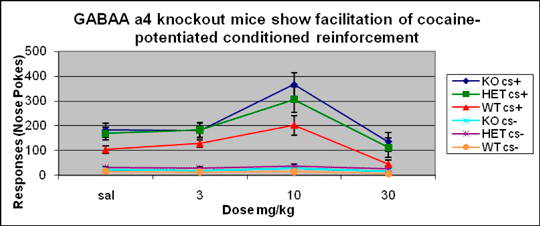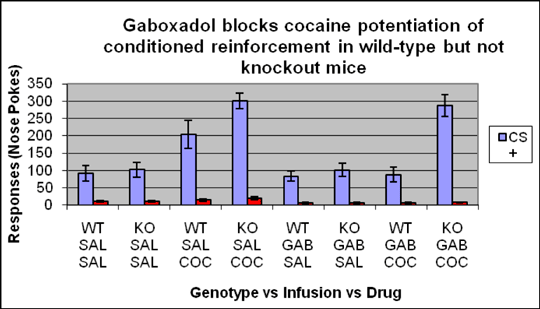Intra-accumbal infusions of Gaboxadol block cocaine potentiation of conditioned reinforcement in wildtype but not GABAA α4 knockout mice Elucidating the mechanisms underlying conditioned reinforcement (CRf) is crucial to understanding the neurobiology of reward and motivational behaviours associated with drugs abuse. In CRf, environmental stimuli that acquire motivational importance by repeated association with primary rewards, support instrumental responding even in the absence of the primary reward. Administration of psychomotor drugs potentiates responding in CRf via an action on the nucleus accumbens (NAc) (Kelley et al, 1991). GABAergic medium spiny neurons (MSNs) form the major neuronal type within the NAc, receiving regulatory glutamatergic and dopaminergic innervation. Immunocytochemical investigation of receptors within the NAc has revealed a high expression of α4-containing GABAA receptors (Pirker et al, 2000). We therefore hypothesised that manipulations of this receptor subtype might influence responding for CRf, or the ability of cocaine to facilitate such behaviour. Male mice (C57BL/6J background, weight between 20-35g) with deletion of α4 subunits Knockout (KO = 8), their Wild-type (WT, n = 8), or Heterologous (HET, n = 8) littermates first underwent Pavlovian conditioning to establish the association between a visual or auditory stimulus (CS) and delivery of a food reinforcer. Subsequently, we investigated the extent to which the mice learned an instrumental response (nose-poke) to activate the CS (CRf responding), and the extent to which cocaine (3 – 30 mg/kg. i.p.) potentiated this responding. There was no difference in acquisition of responding for CRf, but there was an enhancement of cocaine’s ability to potentiate reward-associated behaviours in the KO mice. HET mice were intermediate between KO and WT in this effect.

Fig 1. Knockout mice show significantly higher responding rates than wild-type mice. Significant main effect of genotype of responding rates (F(2,21) = 4.58, p<0.05).
As α4-containing GABAA receptors are largely found extrasynaptically, co-assembled with δ subunits, it was hypothesized that administration of Gaboxadol, a selective GABAA receptor agonist with a preference for δ-subunit containing GABAA receptors, would modulate behavioural responses in CRf. Intra-accumbal administration of Gaboxadol (1.5nmol in 0.5 μL, bilaterally via indwelling canulae implanted previously under isoflurane) blocked the ability of cocaine to potentiate CRf in WT (n = 8), but not KO (n = 7) mice.

Fig 2. Gaboxadol blocks cocaine potentiated increases in responding in wild-type mice, but has no effect in knockout mice. Signicant interaction between genotype and drug administered (F(1,14) = 6.45, p<0.05).
These data suggest compounds acting at α4-containing GABAA receptors may be useful in altering behaviours associated with addiction to cocaine.
Kelley AE, Delfs JM. (1991). Dopamine and conditioned reinforcement. II. Contrasting effects of amphetamine microinjection into the nucleus accumbens with peptide microinjection into the ventral tegmental area. Psychopharmacology. 103(2): 197-203. Pirker S, Schwarzer C, Wieselthaler A, Seighart W, Sperk G. (2000). GABA A receptors: Immunocytochemical Distribution of 13 Subunits in the Adult Rat Brain. Neuroscience. 101(4): 815-550.
|
|

